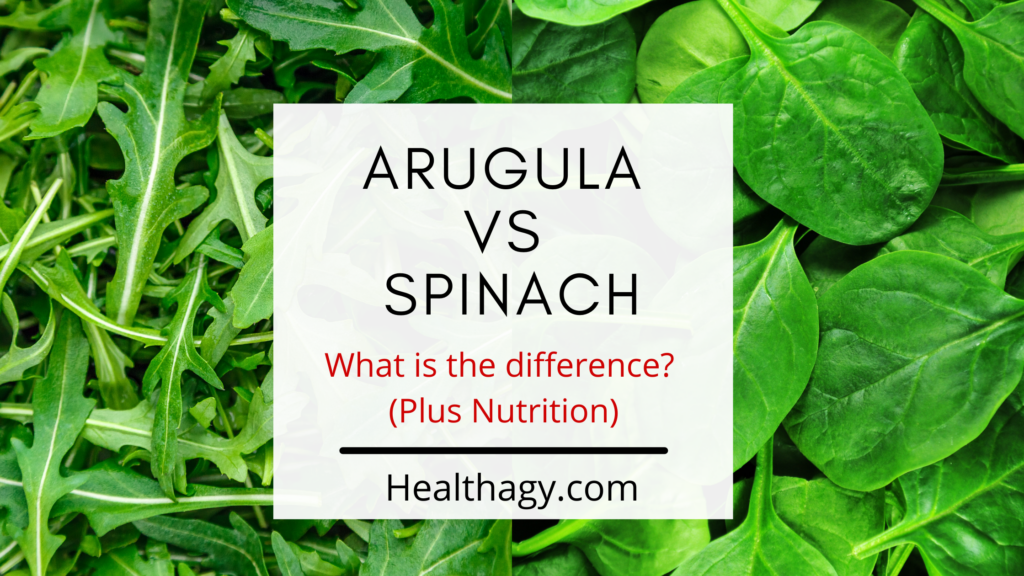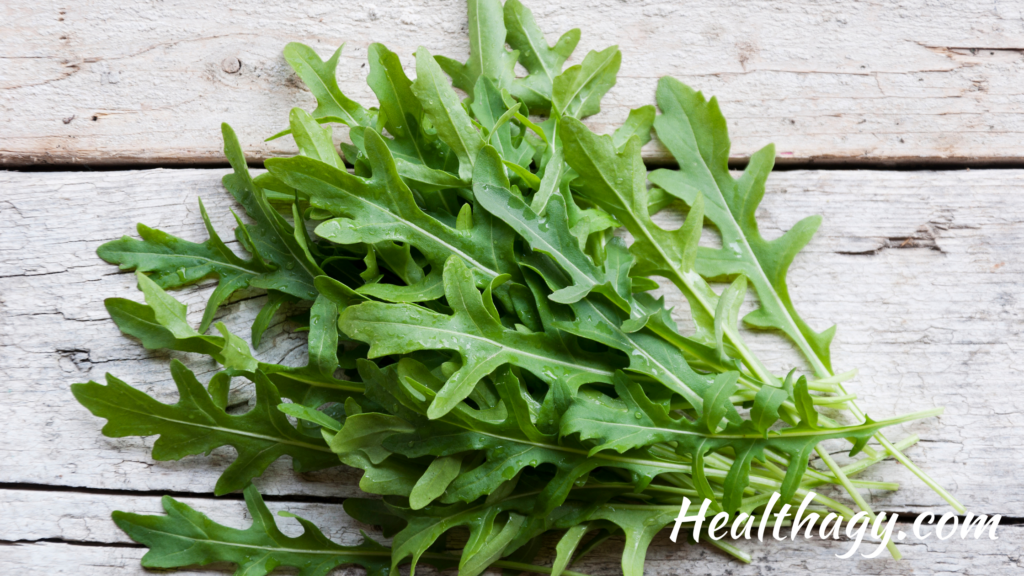
Arugula and spinach are two popular green leafy vegetables jam-packed with rich taste and nutrition and a great addition to a healthy diet. When choosing between arugula vs spinach, you may be left wondering; What is the difference between arugula and spinach? Which one is more nutritious? Let’s take a closer look at these two leafy greens and find out more!
Key Differences Between Arugula Vs Spinach
There are several key differences between arugula vs spinach. Taste is the most notable difference between arugula vs spinach. Arugula has a spicy peppery taste. Spinach has a milder flavor and blends well with other flavors in foods. Both baby spinach leaves and baby arugula leaves have a milder taste than their full-grown, mature counterpart.
Spinach leaves are thicker and denser than the more delicate and thinner arugula leaves. Nutritionally, they are fairly equivalent, although some differences in vitamins and minerals make spinach more nutritionally dense, which are noted further below.

Arugula
Arugula is a bright and aromatic leafy green. It has many nicknames and is sometimes called salad rocket, garden rocket, roquette, rugula, or rucola. Arugula is a popular salad green native to the Mediterranean region. Regular arugula is a leafy green vegetable with a strong peppery, spicy, and sometimes bitter taste. Regular arugula is harvested when the leaves are fully grown.
You may also know baby arugula, which is harvested when the plant is still young. Baby arugula leaves are smaller and more delicate and a milder flavor than their mature counterpart. Baby arugula is delicious on its own, but it is commonly used as part of a salad mix such as a spring mix. A less common variety of arugula, known as Italian arugula or wild arugula, has a more serrated edge and firmer texture, although it is similar in taste and nutritional value.
Arugula makes a tasty salad and is also a common ingredient in many Mediterranean and Italian recipes, including various pasta dishes. Arugula can be eaten raw, heated lightly to make wilted salads, an excellent way to allow the leaves to absorb other flavors, or even fully cooked and incorporated into soups.

Spinach
Spinach is a fresh leafy green with either a curled or smooth leaf shape, which also goes by its proper name, “Spinacia Oleracea.” The smooth, flat spinach varieties are usually more common and sometimes labeled “salad spinach.” While the curled varieties tend to have a firmer texture than the smooth leaves, both varieties are similar in taste and nutritional value.
Baby spinach is harvested when the plant is young, usually between 15 to 30 days after sprouting. Some studies claim that baby spinach is healthier than mature spinach, yet other studies claim the opposite. When examining the nutritional markers, these two varieties are remarkably similar.
Some people may prefer to eat both baby spinach and mature spinach to benefit from both. One measure of the nutritional value of spinach is the color, with darker green leaves being indicative of a higher level of vitamins and minerals.
Spinach is extremely versatile. It makes a simple salad or can be added to other salad greens for extra vitamins and minerals. Raw spinach can be added to many other dishes to add color and nutrition, such as sandwiches, omelets, pizza, pasta dishes, soups, or casseroles. Spinach can be sauteed in olive oil or creamed with milk and parmesan to make a tasty side dish.
Health Benefits of Arugula and Spinach
Arugula
Arugula is a member of the cruciferous vegetables, which are known for their anti-inflammatory, detox, and potential cancer-fighting properties.
While arugula packs a flavor punch, it is not as nutritionally dense as other leafy greens. That is not to say that it is not a healthy option! A single serving of arugula contains nearly half of your daily recommended vitamin A and more than 100% of the recommended vitamin K, in addition to being a significant source of most of the nutrients listed above. Arugula is low in calories, so you can add it to other foods to use as a flavorful condiment without adding in the extra calories of traditional condiments.
Spinach
Spinach may be mild in flavor, but it is packed full of nutritious benefits. Spinach is typically considered one of the most nutritionally dense leafy greens, and the darker in color, the higher the nutritional profile. Just one serving of raw spinach contains more than 100% of the daily recommended amount of vitamin A and vitamin K and 20% of the recommended daily vitamin C.
When cooked, leafy greens become even denser, and one cup of cooked spinach contains more than one-third of your daily requirement of iron. Spinach is also high in fiber, which helps you feel full, and in folate, which helps you convert food into energy and form healthy red blood cells.
Is Arugula or Spinach Healthier?
Like other leafy green vegetables, arugula and spinach are healthy options for making salads and adding texture, flavor, and vitamins to other foods. They are low in calories and carbohydrates, making both these greens a healthy option for people focusing on weight loss and health.
Both these leafy greens are packed full of vitamin K, which helps support bone health and cardiovascular health. They are also great sources of beta carotene and vitamin A, which help support eye health and defend against macular degeneration.
When it comes down to the number of vitamins and minerals, spinach has more nutrient density than arugula, so spinach is the winner if you are looking for the maximum nutrition possible.
One thing to note is that spinach contains tyramine which can cause an upset stomach or other side effects in people who are sensitive to it, especially if they have too much of it. Like any food, always monitor how your body reacts to food to help decide what foods are best for your body.
Arugula vs Spinach Nutrition
This chart shows a side-by-side comparison of the nutrient content of 100 grams of raw arugula against 100 grams of raw spinach in terms of nutrition.
As with many fresh produce foods, the exact amounts of some vitamins and minerals will vary depending on where the produce was grown, what minerals were available in the soil, and when the produce was harvested. Therefore, some minerals are listed simply as greater than ten percent of the recommended daily value (RDV) to show that it is a significant source.
Spinach is a significant source of all the markers listed below. Arugula is not a significant source of vitamin B6, vitamin E, and riboflavin but is a significant source of all other vitamins and minerals in this list.
| Arugula | Spinach | |
| Calories | 25 | 23 |
| Fat | 0.7 grams | 0.4 grams |
| Carbs | 3.7 grams | 3.6 grams |
| Fiber | 1.6 grams | 2.2 grams |
| Protein | 2.6 grams | 2.9 grams |
| Sodium | 27 mg | 79 mg |
| Potassium | 369 mg | 558 mg |
| Vitamin A | 47% RDV | 188% RDV |
| Vitamin B6 | Not a significant source | >10% RDV |
| Vitamin C | >10% RDV | 20% RDV |
| Vitamin E | Not a significant source | >10% RDV |
| Vitamin K | 136% RDV | 604% RDV |
| Calcium | >10% RDV | >10% RDV |
| Folate | >10% RDV | 20% RDV |
| Iron | >10% RDV | >10% RDV |
| Magnesium | >10% RDV | >10% RDV |
| Manganese | >10% RDV | >10% RDV |
| Riboflavin | Not a significant source | >10% RDV |
How to Eat Arugula and Spinach
Arugula has a peppery taste. While some enjoy a good arugula salad, others may find it a bit too spicy as a salad base. If you love a peppery salad, arugula can be great on its own, but it is not as nutrient-dense as other salad bases. Therefore, it makes an excellent addition to a salad mix, bringing a pop of flavor and boosting the antioxidant power of your salad. Arugula can be added to other foods to boost the flavor as well. Try a layer of arugula on a sandwich or add a couple of leaves to top off pasta or pizza.
Spinach has a mild flavor, making it an easy addition to many dishes. It can be used on its own as a salad base or mixed with other greens to ramp up the nutritional value. Because the flavor blends easily with other foods, spinach is an excellent choice for a sweet salad, such as spinach, strawberry, and feta salad with balsamic dressing. Raw spinach is an easy way to add greens to a sandwich, and cooked spinach tastes great added into an omelet or sauteed in olive oil.
When it comes to leafy green vegetables, leaves darker in color tend to be more nutritionally dense, so skip faded pieces and look for bunches with a deep green color when you are at the grocery store.
Arugula Substitutes
There are several great substitutes for arugula you can use. Watercress is an excellent substitute for arugula as it also has a peppery flavor. Spinach or dandelion greens are some other commonly recommended substitutes. They are a great option for people who find the taste of arugula too peppery for some dishes, as both spinach and dandelion greens have a milder flavor. For a similar texture with a slightly spicy and bitter flavor, try radicchio leaves.
Spinach Substitutes
There are a few leafy greens you can use as a spinach substitute. Romaine lettuce is a great choice and has a milder taste than spinach. Arugula is also a great alternative to spinach, as they do have a similar taste- but arugula will have that added peppery and spicy taste. Amaranth greens and beet greens are also similar in texture and taste. Escarole is also a great mild leafy green that will work.
The Takeaway
Both arugula and spinach are healthy options. They are both excellent bases for salads and can also be used in a mix of leafy greens. They are both low in calories and rich in vitamins and minerals, although spinach does take the lead in being more nutritionally dense.
Spinach offers a mild flavor, making it easy to add greens to many different foods and recipes without changing the flavors you already love. Arugula brings a peppery, slightly spicy flavor and can kick a bland recipe up a notch!
Try to avoid limp, light-colored bunches when selecting your leafy greens. Instead, look for pieces with bright or dark green colors and a firm texture to ensure you are getting the most nutritious selection possible.
Up Next:
The 7 Best Arugula Substitutes
10 Foods to Lower Blood Pressure
Karla Kueber is a Certified Evidence Based EFT Practioner and Health Coach, with a double Masters Degree in Education. She works with people to overcome emotional eating, curb cravings, and overcome resistance to eating new healthy foods. You can learn more about coaching with her here.